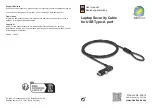
5-4 Using Multimedia
Line-In
Analog signals come in through the NEC Versa 6060’s Line-In port. The
analog signals are converted into digital bits and bytes (digitized) through a
converter known as an ADC (analog-to-digital converter). The resulting
digital sound bytes can be stored, edited, processed, and transferred. You
can record ambient sound effects, specific sound effects, or music to en-
hance a presentation.
Ambient sound effects create a sense of place or environment and include
sounds such as rain, heavy traffic, chirping birds. Specific sound effects accent
or illustrate an action. Examples of specific sound effects include footsteps,
a crash, a clock chime. There are many sources of prerecorded sound effects
available on the market, or you can record your own sounds.
Line-In accepts analog signals from external devices such as a tape deck, a
stereo CD-player, a docking station, or a stereo tuner. The Line-In port has
a mini-type connector. You may need an adapter to connect your input de-
vice to the NEC Versa 6060 through Line-In.
CD-ROM Input
You can record music and sound effects from a CD (compact disc) and store
them on your hard disk. The audio signal from the CD-ROM reader con-
nects directly to your NEC Versa 6060. Simply follow the instructions in
“Recording” to record sound from your CD player.
Microphone
You can capture and record sounds through the internal microphone on the NEC
Versa 6060 or through an external microphone that connects to the system
through the microphone port. You can record voice-overs for narration, re-
minders, or special instructions.
See “Recording,” explained earlier in this chapter, for details about
recording sound with the microphone. Although the example given shows
how to record sound from a tape, the procedure is the same for recording
with a microphone.
















































